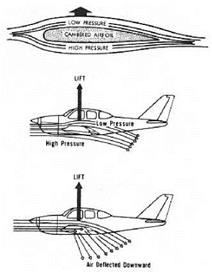Lift Has Its Limits
Engineers have created a large variety of airfoil designs based on whether they want their planes to make use primarily of Newton’s action-reaction lift or Bernoulli’s low-pressure lift. The type of lift depends on the type of plane and the type of flying it will be expected to do.
|
When Bernoulli joins forces with Newton, the result is lift. (FAA Flight Training Handbook) |
If you slice a wing from leading edge to trailing edge, you see its cross section. Some cross sections have a stout, thick shape. These generally produce a lot of Bernoulli-style lift thanks to the highly curved upper surface, and enable the plane to fly at relatively low speeds of 50 to 60 m. p.h. You find these wings on general aviation airplanes and any others that need to fly slowly.
Other wing cross sections are nearly as slender as the cross section of a knife blade. These wings produce very little lift on the basis of their shape, so they rely on high-powered engines, usually jets, that can produce lots of speed. You generally find knifelike wings on high-speed jet fighters and civilian planes like the Concorde, which create tremendous engine power, or thrust. These wings rely less on Bernoulli’s low-pressure lift and more on Newton’s action-reaction lift.












